Experimental Studies and Computational Fluid Dynamics Simulations to Evaluate the Characteristics of the Air Velocity Profile Generated by the Positive Pressure Ventilator
Abstract
1. Introduction
2. Materials and Methods
2.1. Research Methodology in Real-Scale: Velocity Profile on the Door Opening Surface in Open Flow
2.2. Methodology for Measuring the Volumetric Flow Rate of Positive Pressure Ventilators
2.3. CFD Simulation Methodology
3. Results and Discussion
4. Conclusions
Author Contributions
Funding
Institutional Review Board Statement
Informed Consent Statement
Data Availability Statement
Conflicts of Interest
Appendix A
| Measurement Distance from the Rotor Surface [mm] | Flow Rate Obtained by Positive Pressure Ventilator [m3/h] | |
|---|---|---|
| AVG | SD | |
| 50 | 12,541 | 404 |
| 100 | 12,482 | 314 |
| Distance of the Positive Pressure Ventilator from the Door Opening (1 m) | ||||||||||||
|---|---|---|---|---|---|---|---|---|---|---|---|---|
| Case | x (mm) | |||||||||||
| 91 | 273 | 455 | 637 | 819 | ||||||||
| AVG | SD | AVG | SD | AVG | SD | AVG | SD | AVG | SD | |||
| y (mm) | 101.5 | EXP | 1.00 | 0.93 | 8.26 | 0.28 | 24.91 | 0.35 | 8.67 | 0.34 | 1.24 | 1.00 |
| CFD | 0.40 | 5.82 | 4.99 | 5.20 | 0.44 | |||||||
| 304.5 | EXP | 1.38 | 0.77 | 19.29 | 0.77 | 27.27 | 0.62 | 17.74 | 0.63 | 1.33 | 1.38 | |
| CFD | 0.68 | 19.38 | 18.41 | 14.39 | 0.71 | |||||||
| 507.5 | EXP | 0.72 | 0.70 | 4.79 | 0.61 | 12.92 | 0.76 | 4.86 | 0.59 | 0.90 | 0.72 | |
| CFD | 0.68 | 21.05 | 20.09 | 20.01 | 0.63 | |||||||
| 710.5 | EXP | 1.03 | 0.52 | 1.02 | 0.94 | 1.15 | 0.96 | 0.86 | 0.45 | 0.55 | 1.03 | |
| CFD | 0.45 | 1.33 | 4.35 | 3.24 | 0.43 | |||||||
| 913.5 | EXP | 0.85 | 0.49 | 0.56 | 0.53 | 0.41 | 0.49 | 0.46 | 0.58 | 0.43 | 0.85 | |
| CFD | 0.37 | 0.36 | 0.34 | 0.38 | 0.36 | |||||||
| 1116.5 | EXP | 0.88 | 0.22 | 0.51 | 0.20 | 0.55 | 0.57 | 0.24 | 0.53 | 0.44 | 0.43 | |
| CFD | 0.32 | 0.30 | 0.29 | 0.31 | 0.31 | |||||||
| 1319.5 | EXP | 0.52 | 0.20 | 0.39 | 0.43 | 0.73 | 0.13 | 1.20 | 0.62 | 0.42 | 0.07 | |
| CFD | 0.27 | 0.25 | 0.25 | 0.25 | 0.27 | 0.27 | ||||||
| 1522.5 | EXP | 0.22 | 0.35 | 0.23 | 0.30 | 0.77 | 0.70 | 0.29 | 0.39 | 0.53 | 0.12 | |
| CFD | 0.24 | 0.23 | 0.24 | 0.22 | 0.22 | 0.24 | ||||||
| 1725.5 | EXP | 0.60 | 0.26 | 0.20 | 0.10 | 0.24 | 0.39 | 0.21 | 0.27 | 0.29 | 0.30 | |
| CFD | 0.23 | 0.21 | 0.22 | 0.22 | 0.23 | |||||||
| 1928.5 | EXP | 0.20 | 0.33 | 0.19 | 0.06 | 0.16 | 0.47 | 0.20 | 0.21 | 0.22 | 0.14 | |
| CFD | 0.12 | 0.10 | 0.10 | 0.11 | 0.10 | |||||||
| Distance of the Positive Pressure Ventilator from the Door Opening (2 m) | ||||||||||||
|---|---|---|---|---|---|---|---|---|---|---|---|---|
| Case | x (mm) | |||||||||||
| 91 | 273 | 455 | 637 | 819 | ||||||||
| AVG | SD | AVG | SD | AVG | SD | AVG | SD | AVG | SD | |||
| y (mm) | 101.5 | CFD | 0.11 | - | 0.08 | - | 0.09 | - | 0.08 | - | 0.09 | - |
| 304.5 | EXP | 0.21 | - | 0.19 | - | 0.20 | - | 0.19 | - | 0.21 | - | |
| 507.5 | CFD | 0.22 | - | 0.25 | - | 0.26 | - | 0.23 | - | 0.22 | - | |
| 710.5 | CFD | 0.24 | - | 0.29 | - | 0.30 | - | 0.26 | - | 0.25 | - | |
| 913.5 | CFD | 0.29 | - | 0.35 | - | 0.37 | - | 0.33 | - | 0.30 | - | |
| 1116.5 | CFD | 0.41 | - | 0.60 | - | 0.62 | - | 0.54 | - | 0.40 | - | |
| 1319.5 | CFD | 1.49 | - | 7.44 | - | 8.06 | - | 6.07 | - | 1.49 | - | |
| 1522.5 | CFD | 4.02 | - | 18.28 | - | 18.62 | - | 17.48 | - | 4.46 | - | |
| 1725.5 | CFD | 2.29 | - | 18.26 | - | 18.25 | - | 12.94 | - | 2.34 | - | |
| 1928.5 | CFD | 0.93 | - | 9.31 | - | 11.62 | - | 7.94 | - | 0.84 | - | |
| Distance of the Positive Pressure Ventilator from the Door Opening (3 m) | ||||||||||||
|---|---|---|---|---|---|---|---|---|---|---|---|---|
| Case | x (mm) | |||||||||||
| 91 | 273 | 455 | 637 | 819 | ||||||||
| AVG | SD | AVG | SD | AVG | SD | AVG | SD | AVG | SD | |||
| y (mm) | 101.5 | EXP | 10.63 | 0.93 | 15.31 | 0.28 | 18.00 | 0.35 | 14.44 | 0.34 | 8.74 | 0.49 |
| CFD | 4.47 | - | 11.71 | - | 11.99 | - | 11.99 | - | 3.39 | - | ||
| 304.5 | EXP | 7.21 | 0.77 | 14.95 | 0.77 | 18.48 | 0.62 | 14.36 | 0.63 | 6.67 | 0.55 | |
| CFD | 5.06 | - | 14.06 | - | 15.68 | - | 12.11 | - | 3.47 | - | ||
| 507.5 | EXP | 4.96 | 0.70 | 9.59 | 0.61 | 12.58 | 0.76 | 10.12 | 0.59 | 5.48 | 0.70 | |
| CFD | 7.63 | - | 15.30 | - | 16.47 | - | 15.66 | - | 6.20 | - | ||
| 710.5 | EXP | 2.12 | 0.52 | 3.88 | 0.94 | 4.19 | 0.96 | 4.31 | 0.45 | 1.78 | 0.43 | |
| CFD | 3.23 | - | 8.60 | - | 8.05 | - | 8.14 | - | 4.34 | - | ||
| 913.5 | EXP | 1.13 | 0.49 | 0.90 | 0.53 | 0.88 | 0.49 | 0.84 | 0.58 | 0.94 | 0.36 | |
| CFD | 0.76 | - | 1.64 | - | 1.61 | - | 1.48 | - | 0.87 | - | ||
| 1116.5 | EXP | 0.75 | 0.22 | 0.62 | 0.20 | 1.20 | 0.57 | 0.78 | 0.53 | 0.93 | 0.43 | |
| CFD | 0.52 | - | 0.62 | - | 0.56 | - | 0.59 | - | 0.59 | - | ||
| 1319.5 | EXP | 0.37 | 0.20 | 1.02 | 0.43 | 0.70 | 0.13 | 0.72 | 0.62 | 0.57 | 0.07 | |
| CFD | 0.35 | - | 0.40 | - | 0.42 | - | 0.35 | - | 0.33 | - | ||
| 1522.5 | EXP | 0.40 | 0.35 | 0.83 | 0.30 | 0.93 | 0.70 | 0.79 | 0.39 | 0.50 | 0.12 | |
| CFD | 0.25 | - | 0.31 | - | 0.33 | - | 0.32 | - | 0.28 | - | ||
| 1725.5 | EXP | 0.37 | 0.26 | 0.31 | 0.10 | 0.43 | 0.39 | 0.46 | 0.27 | 0.42 | 0.30 | |
| CFD | 0.24 | - | 0.24 | - | 0.25 | - | 0.15 | - | 0.24 | - | ||
| 1928.5 | EXP | 0.40 | 0.33 | 0.29 | 0.06 | 0.27 | 0.47 | 0.23 | 0.21 | 0.25 | 0.14 | |
| CFD | 0.09 | - | 0.11 | - | 0.11 | - | 0.11 | - | 0.13 | - | ||
| Distance of the Positive Pressure Ventilator from the Door Opening (4 m) | ||||||||||||
|---|---|---|---|---|---|---|---|---|---|---|---|---|
| Case | x (mm) | |||||||||||
| 91 | 273 | 455 | 637 | 819 | ||||||||
| AVG | SD | AVG | SD | AVG | SD | AVG | SD | AVG | SD | |||
| y (mm) | 101.5 | EXP | 10.99 | 0.93 | 14.19 | 0.28 | 15.19 | 0.35 | 13.12 | 0.34 | 9.80 | 0.49 |
| CFD | 11.65 | 11.02 | 11.22 | 4.32 | 4.40 | |||||||
| 304.5 | EXP | 8.25 | 0.77 | 12.82 | 0.77 | 14.88 | 0.62 | 11.41 | 0.63 | 8.22 | 0.55 | |
| CFD | 13.69 | 15.52 | 12.52 | 3.90 | 16.55 | |||||||
| 507.5 | EXP | 7.16 | 0.70 | 10.01 | 0.61 | 10.54 | 0.76 | 11.08 | 0.59 | 6.83 | 0.70 | |
| CFD | 9.32 | 16.51 | 15.47 | 4.84 | 3.98 | |||||||
| 710.5 | EXP | 3.92 | 0.52 | 6.40 | 0.94 | 6.55 | 0.96 | 4.86 | 0.45 | 4.03 | 0.43 | |
| CFD | 7.26 | 8.46 | 7.54 | 4.01 | 0.62 | |||||||
| 913.5 | EXP | 1.76 | 0.49 | 2.54 | 0.53 | 2.29 | 0.49 | 2.24 | 0.58 | 1.49 | 0.36 | |
| CFD | 0.96 | 0.84 | 0.93 | 0.64 | 0.37 | |||||||
| 1116.5 | EXP | 0.93 | 0.22 | 1.05 | 0.20 | 1.29 | 0.57 | 1.93 | 0.53 | 2.13 | 0.43 | |
| CFD | 0.50 | 0.51 | 0.49 | 0.39 | 0.29 | |||||||
| 1319.5 | EXP | 0.77 | 0.20 | 2.26 | 0.43 | 0.59 | 0.13 | 1.34 | 0.62 | 0.45 | 0.07 | |
| CFD | 0.43 | 0.37 | 0.35 | 0.31 | 0.23 | |||||||
| 1522.5 | EXP | 1.57 | 0.35 | 1.18 | 0.30 | 0.85 | 0.70 | 1.03 | 0.39 | 0.42 | 0.12 | |
| CFD | 0.31 | 0.31 | 0.32 | 0.25 | 0.24 | |||||||
| 1725.5 | EXP | 0.61 | 0.26 | 0.49 | 0.10 | 0.72 | 0.39 | 1.37 | 0.27 | 0.96 | 0.30 | |
| CFD | 0.18 | 0.24 | 0.19 | 0.23 | 0.11 | |||||||
| 1928.5 | EXP | 0.74 | 0.33 | 0.34 | 0.06 | 1.07 | 0.47 | 0.61 | 0.21 | 0.59 | 0.14 | |
| CFD | 0.14 | 0.12 | 0.11 | 0.10 | 3.70 | |||||||
| Distance of the Positive Pressure Ventilator from the Door Opening (5 m) | ||||||||||||
|---|---|---|---|---|---|---|---|---|---|---|---|---|
| Case | x (mm) | |||||||||||
| 91 | 273 | 455 | 637 | 819 | ||||||||
| AVG | SD | AVG | SD | AVG | SD | AVG | SD | AVG | SD | |||
| y (mm) | 101.5 | EXP | 10.44 | 0.93 | 13.07 | 0.28 | 13.93 | 0.35 | 12.30 | 0.34 | 9.89 | 0.49 |
| CFD | 10.42 | - | 11.86 | 11.02 | 7.31 | 6.08 | ||||||
| 304.5 | EXP | 9.12 | 0.77 | 11.37 | 0.77 | 12.16 | 0.62 | 11.01 | 0.63 | 8.55 | 0.55 | |
| CFD | 12.07 | - | 12.71 | 10.95 | 6.49 | 11.39 | ||||||
| 507.5 | EXP | 7.06 | 0.70 | 9.04 | 0.61 | 9.78 | 0.76 | 8.03 | 0.59 | 7.08 | 0.70 | |
| CFD | 9.12 | - | 13.15 | 12.06 | 6.85 | 6.36 | ||||||
| 710.5 | EXP | 5.11 | 0.52 | 6.64 | 0.94 | 6.97 | 0.96 | 5.96 | 0.45 | 5.09 | 0.43 | |
| CFD | 6.34 | 9.68 | 9.49 | 6.85 | 3.83 | |||||||
| 913.5 | EXP | 3.19 | 0.49 | 3.06 | 0.53 | 3.70 | 0.49 | 3.51 | 0.58 | 3.23 | 0.36 | |
| CFD | 4.02 | 4.89 | 4.63 | 3.00 | 2.29 | |||||||
| 1116.5 | EXP | 1.93 | 0.22 | 1.48 | 0.20 | 1.70 | 0.57 | 1.40 | 0.53 | 1.71 | 0.43 | |
| CFD | 1.73 | 1.90 | 1.23 | 1.38 | 1.46 | |||||||
| 1319.5 | EXP | 1.35 | 0.20 | 0.86 | 0.43 | 1.10 | 0.13 | 1.34 | 0.62 | 0.76 | 0.07 | |
| CFD | 0.70 | 0.60 | 0.54 | 0.47 | 0.50 | |||||||
| 1522.5 | EXP | 0.68 | 0.35 | 0.98 | 0.30 | 0.58 | 0.70 | 0.95 | 0.39 | 0.81 | 0.12 | |
| CFD | 0.48 | 0.37 | 0.43 | 0.34 | 0.48 | |||||||
| 1725.5 | EXP | 0.78 | 0.26 | 0.62 | 0.10 | 1.66 | 0.39 | 0.56 | 0.27 | 1.23 | 0.30 | |
| CFD | 0.41 | 0.32 | 0.35 | 0.41 | 0.27 | |||||||
| 1928.5 | EXP | 0.98 | 0.33 | 1.09 | 0.06 | 0.82 | 0.47 | 0.58 | 0.21 | 0.51 | 0.14 | |
| CFD | 0.18 | 0.15 | 0.11 | 0.14 | 5.48 | |||||||
| Distance of the Positive Pressure Ventilator from the Door Opening (2 m) | ||||||||||||
|---|---|---|---|---|---|---|---|---|---|---|---|---|
| Case | x (mm) | |||||||||||
| 91 | 273 | 455 | 637 | 819 | ||||||||
| AVG | SD | AVG | SD | AVG | SD | AVG | SD | AVG | SD | |||
| y (mm) | 101.5 | CFD | 8.18 | - | 10.71 | - | 11.10 | - | 10.27 | - | 8.15 | - |
| 304.5 | EXP | 7.75 | - | 11.00 | - | 11.53 | - | 10.64 | - | 8.17 | - | |
| 507.5 | CFD | 7.19 | - | 9.66 | - | 9.98 | - | 9.27 | - | 7.41 | - | |
| 710.5 | CFD | 6.30 | - | 7.83 | - | 7.81 | - | 7.34 | - | 6.18 | - | |
| 913.5 | CFD | 4.45 | - | 4.75 | - | 4.48 | - | 4.26 | - | 3.86 | - | |
| 1116.5 | CFD | 2.93 | - | 2.63 | - | 2.42 | - | 2.21 | - | 1.99 | - | |
| 1319.5 | CFD | 1.62 | - | 1.33 | - | 1.20 | - | 1.02 | - | 0.88 | - | |
| 1522.5 | CFD | 0.85 | - | 0.69 | - | 0.57 | - | 0.54 | - | 0.49 | - | |
| 1725.5 | CFD | 0.50 | - | 0.48 | - | 0.41 | - | 0.45 | - | 0.42 | - | |
| 1928.5 | CFD | 0.35 | - | 0.34 | - | 0.30 | - | 0.26 | - | 0.35 | - | |
| Distance of the Positive Pressure Ventilator from the Door Opening (7 m) | ||||||||||||
|---|---|---|---|---|---|---|---|---|---|---|---|---|
| Case | x (mm) | |||||||||||
| 91 | 273 | 455 | 637 | 819 | ||||||||
| AVG | SD | AVG | SD | AVG | SD | AVG | SD | AVG | SD | |||
| y (mm) | 101.5 | EXP | 9.31 | 0.93 | 10.46 | 0.28 | 10.65 | 0.35 | 10.10 | 0.34 | 9.58 | 0.49 |
| CFD | 8.49 | 9.07 | 9.25 | 8.98 | 7.82 | |||||||
| 304.5 | EXP | 8.37 | 0.77 | 9.14 | 0.77 | 10.02 | 0.62 | 9.50 | 0.63 | 8.70 | 0.55 | |
| CFD | 9.61 | 10.15 | 9.57 | 8.74 | 8.59 | |||||||
| 507.5 | EXP | 6.56 | 0.70 | 8.04 | 0.61 | 8.14 | 0.76 | 7.96 | 0.59 | 7.38 | 0.70 | |
| CFD | 7.71 | 8.61 | 8.33 | 6.61 | 6.60 | |||||||
| 710.5 | EXP | 5.36 | 0.52 | 6.16 | 0.94 | 6.45 | 0.96 | 6.49 | 0.45 | 6.10 | 0.43 | |
| CFD | 7.46 | 7.32 | 6.37 | 5.86 | 5.55 | |||||||
| 913.5 | EXP | 4.07 | 0.49 | 4.71 | 0.53 | 4.55 | 0.49 | 4.65 | 0.58 | 4.88 | 0.36 | |
| CFD | 4.33 | 3.86 | 3.29 | 3.77 | 3.44 | |||||||
| 1116.5 | EXP | 2.38 | 0.22 | 3.20 | 0.20 | 2.90 | 0.57 | 3.15 | 0.53 | 3.69 | 0.43 | |
| CFD | 2.25 | 1.92 | 2.20 | 2.38 | 1.93 | |||||||
| 1319.5 | EXP | 1.33 | 0.20 | 2.04 | 0.43 | 1.56 | 0.13 | 2.14 | 0.62 | 2.97 | 0.07 | |
| CFD | 1.49 | 0.63 | 0.73 | 1.14 | 1.70 | |||||||
| 1522.5 | EXP | 1.13 | 0.35 | 1.19 | 0.30 | 1.15 | 0.70 | 1.47 | 0.39 | 2.13 | 0.12 | |
| CFD | 0.67 | 0.49 | 0.56 | 0.86 | 1.99 | |||||||
| 1725.5 | EXP | 0.75 | 0.26 | 1.00 | 0.10 | 0.87 | 0.39 | 0.91 | 0.27 | 1.03 | 0.30 | |
| CFD | 0.43 | 0.54 | 0.40 | 0.91 | 1.04 | |||||||
| 1928.5 | EXP | 1.00 | 0.33 | 0.81 | 0.06 | 1.09 | 0.47 | 1.08 | 0.21 | 0.96 | 0.14 | |
| CFD | 0.21 | 0.30 | 0.28 | 0.51 | 8.06 | |||||||
| Ventilator Positioning Distance [m] | Case | Volumetric Airflow Rate [m3/h] | |
|---|---|---|---|
| AVG | SD | ||
| 1 | experiment | 20.123.4 | 1404 |
| CFD analysis | 19.742.6 | - | |
| difference [%] | 1.9 | ||
| 2 | experiment | - | - |
| CFD analysis | 23.717.2 | - | |
| difference [%] | - | ||
| 3 | experiment | 27.230.8 | 2492 |
| CFD analysis | 26.294.3 | - | |
| difference [%] | 3.4 | ||
| 4 | experiment | 29.705.1 | 2973 |
| CFD analysis | 28.282.9 | ||
| difference [%] | 1.6 | ||
| 5 | experiment | 29.695.0 | 2686 |
| CFD analysis | 29.220.3 | - | |
| difference [%] | 1.6 | ||
| 6 | experiment | - | - |
| CFD analysis | 29.396.9 | - | |
| difference [%] | - | ||
| 7 | experiment | 30.156.3 | 2938 |
| CFD analysis | 29.019.3 | - | |
| difference [%] | 3.8 | ||
References
- Garcia, K.; Kauffmann, R.; Schelble, R. Positive Pressure Attack for Ventilation & Firefighting; PennWell Books: Tulsa, OK, USA, 2006; ISBN 978-1-59370-048-5. [Google Scholar]
- Svensson, S. A Study of Tactical Patterns during Fire Fighting Operations. Fire Saf. J. 2002, 37, 673–695. [Google Scholar] [CrossRef]
- Warguła, Ł.; Kaczmarzyk, P. Legal Regulations of Restrictions of Air Pollution Made by Mobile Positive Pressure Fans—The Case Study for Europe: A Review. Energies 2022, 15, 7672. [Google Scholar] [CrossRef]
- Kaczmarzyk, P.; Warguła, Ł.; Janik, P.; Krawiec, P. Influence of Measurement Methodologies for the Volumetric Air Flow Rate of Mobile Positive Pressure Fans on Drive Unit Performance. Energies 2022, 15, 3953. [Google Scholar] [CrossRef]
- Thielens, M. Assessment of Ventilation Procedures for Fire Fighting in Buildings; Ghent University: Ghent, Belgium, 2018. [Google Scholar]
- Popov, G.S.; Klimentov, K.V.; Kostov, B.Z. Investigation of the Energy Consumption in Regulating the Flow Rate of Fan Systems. IOP Conf. Ser. Mater. Sci. Eng. 2019, 595, 012012. [Google Scholar] [CrossRef]
- Liu, X.; Liu, J.; Wang, D.; Zhao, L. Experimental and Numerical Simulation Investigations of an Axial Flow Fan Performance in High-Altitude Environments. Energy 2021, 234, 121281. [Google Scholar] [CrossRef]
- Tanaka, S.; Murata, S. Scale Effects in Cross-Flow Fans: Effects of Fan Dimensions on Performance Curves. JSME Int. J. Ser. B 1994, 37, 844–852. [Google Scholar] [CrossRef][Green Version]
- Bayomi, N.N.; Abdel Hafiz, A.; Osman, A.M. Effect of Inlet Straighteners on Centrifugal Fan Performance. Energy Convers. Manag. 2006, 47, 3307–3318. [Google Scholar] [CrossRef]
- Pędzisz, I.; Magryta, P.; Pietrykowski, K. Computational Fluid Dynamics Studies of a Vertical Axis Wind Turbine with a Variable Swept Area. Adv. Sci. Technol. Res. J. 2024, 18, 333–348. [Google Scholar] [CrossRef]
- Fan, C.; Amankwa Adjei, R.; Wu, Y.; Wang, A. Parametric Study on the Aerodynamic Performance of a Ducted-Fan Rotor Using Free-Form Method. Aerosp. Sci. Technol. 2020, 101, 105842. [Google Scholar] [CrossRef]
- Moczko, P.; Odyjas, P.; Pietrusiak, D.; Więckowski, J.; Scholz, P.; Dix, M.; Osiecki, T.; Timmel, T.; Kroll, L. Enhancing Efficiency of Industrial Centrifugal Fans Using Blade Adjustment Mechanism. Energies 2022, 15, 893. [Google Scholar] [CrossRef]
- Odyjas, P.; Więckowski, J.; Pietrusiak, D.; Moczko, P. Challenges in the Design of a New Centrifugal Fan with Variable Impeller Geometry. Acta Mech. Et Autom. 2023, 17, 16–27. [Google Scholar] [CrossRef]
- Kaczmarzyk, P.; Warguła, Ł.; Krawiec, P.; Janik, P.; Noske, R.; Klapsa, W. Influence of the Positive Pressure Ventilator Setting Distance in Front of the Doorway on the Effectiveness of Tactical Mechanical Ventilation in a Multistory Building. Appl. Sci. 2023, 13, 5536. [Google Scholar] [CrossRef]
- Ezekoye, O.A.; Svensson, S.; Nicks, R. Investigating Positive Pressure Ventilation; Royal Holloway College: Egham, UK, 2007. [Google Scholar]
- Szpica, D.; Mieczkowski, G.; Borawski, A.; Leisis, V.; Diliunas, S.; Pilkaite, T. The Computational Fluid Dynamics (CFD) Analysis of the Pressure Sensor Used in Pulse-Operated Low-Pressure Gas-Phase Solenoid Valve Measurements. Sensors 2021, 21, 8287. [Google Scholar] [CrossRef]
- Caban, J.; Vrabel, J.; Górnicka, D.; Nowak, R.; Jankiewicz, M.; Matijošius, J.; Palka, M. Overview of Energy Harvesting Technologies Used in Road Vehicles. Energies 2023, 16, 3787. [Google Scholar] [CrossRef]
- Zhang, S.; Lu, L.; Wen, T.; Dong, C. Turbulent Heat Transfer and Flow Analysis of Hybrid Al2O3-CuO/Water Nanofluid: An Experiment and CFD Simulation Study. Appl. Therm. Eng. 2021, 188, 116589. [Google Scholar] [CrossRef]
- Shirzadi, M.; Mirzaei, P.A.; Tominaga, Y. RANS Model Calibration Using Stochastic Optimization for Accuracy Improvement of Urban Airflow CFD Modeling. J. Build. Eng. 2020, 32, 101756. [Google Scholar] [CrossRef]
- Kaczmarzyk, P.; Małozięć, D.; Burdzy, T.; Ziegler, B.; Krawiec, P.; Dziechciarz, A.; Warguła, Ł. Analysis of the Air Stream Flow Parameters Generated by the Positive Pressure Ventilator—Full Scale Experiment and CFD Simulation. Sci. Rep. 2024, 14, 6852. [Google Scholar] [CrossRef]
- Kerber, S. Evaluation of the Ability of Fire Dynamic Simulator to Simulate Positive Pressure Ventilation in the Laboratory and Practical Scenarios; National Institute of Standards and Technology: Gaithersburg, MD, USA, 2006. [Google Scholar]
- Weinschenk, C.; Beal, C.; Ezekoye, O. Modeling Fan-Driven Flows for Firefighting Tactics Using Simple Analytical Models and CFD. J. Fire Prot. Eng. 2011, 21, 85–114. [Google Scholar] [CrossRef]
- Panindre, P.; Mousavi, N.S.S.; Kumar, S. Improvement of Positive Pressure Ventilation by Optimizing Stairwell Door Opening Area. Fire Saf. J. 2017, 92, 195–198. [Google Scholar] [CrossRef]
- Panindre, P.; Mousavi, N.S.S.; Kumar, S. Positive Pressure Ventilation for Fighting Wind-Driven High-Rise Fires: Simulation-Based Analysis and Optimization. Fire Saf. J. 2017, 87, 57–64. [Google Scholar] [CrossRef]
- Fritsche, M.; Epple, P.; Delgado, A. Development of a Measurement Method for the Classification and Performance Evaluation of Positive Pressure Ventilation (PPV) Fans; American Society of Mechanical Engineers Digital Collection: New York, NY, USA, 2018. [Google Scholar]
- ANSYS. ANSYS CFX-Solver Theory Guide (Release 11.0); ANSYS, Inc.: Canonsburg, PA, USA, 2006. [Google Scholar]
- Kaczmarzyk, P.; Warguła, Ł.; Janik, P. Experimental Studies of the Influence of Mobile Fan Positioning Parameters on the Ability to Transport the Air Stream into the Door Opening. Sci. Rep. 2023, 13, 14976. [Google Scholar] [CrossRef]
- Warguła, Ł.; Kaczmarzyk, P.; Lijewski, P.; Fuć, P.; Markiewicz, F.; Małozięć, D.; Wieczorek, B. Effect of the Volumetric Flow Rate Measurement Methodology of Positive Pressure Ventilators on the Parameters of the Drive Unit. Energies 2023, 16, 4515. [Google Scholar] [CrossRef]
- ANSI/AMCA Standard 240-15; Laboratory Methods of Testing Positive Pressure Ventilators for Aerodynamic Performance Rating. ANSI: Washington, DC, USA, 2015.
- ISO 5221:1984; Air Distribution and Air Diffusion—Rules to Methods of Measuring Air Flow Rate in an Air Handling Duct. ISO: Geneva, Switzerland, 1984.
- AMCA 210-16; ANSI/ASHRAE 51-16; Laboratory Methods of Testing Fans Certified Aerodynamic Performance Rating. Air Movement and Control Association International: Arlington Heights, IL, USA, 2016.
- Fire Dynamics Simulator (FDS) and Smokeview (SMV); National Institute of Standards and Technology: Gaithersburg, MD, USA, 2024.
- McGrattan, K.B.; Hamins, D.W. Stroup, Sprinkler, Smoke and Heat Vent, Draft Curtain Interaction: Large Scale Experiments and Model Development; NISTIR 6196-1; Building and Fire Research Laboratory: Gaithersburg, MD, USA, 1998. [Google Scholar]
- Huang, Y.; Sun, Y.; Wang, M.; Zheng, X.; Liu, W.; Xie, H.; Lin, C. Thermal Runaway Simulation of Lithium Iron Phosphate Battery Based on Pyrosim Software. In Proceedings of the 2023 2nd International Conference on Clean Energy Storage and Power Engineering (CESPE), Xi’an, China, 15–16 December 2023; pp. 52–56. [Google Scholar]
- Vinay; Raja, S.; Tauseef, S.M.; Varadharajan, S. Investigating the Impact of Oxygen Concentration on Fire Dynamics Using Numerical Simulation with FDS. Process Saf. Environ. Prot. 2023, 178, 195–203. [Google Scholar] [CrossRef]
- Deardorff, J.W. Stratocumulus-capped mixed layers derived from a three-dimensional model. Bound.-Layer Meteorol. 1980, 18, 495–527. [Google Scholar] [CrossRef]
- Fire Dynamics Simulator (Version 4) User’s Guide; National Institute of Standards and Technology Special Publication 1019; National Institute of Standards and Technology: Gaithersburg, MD, USA, 2024. [CrossRef]
- McGrattan, K.; Hostikka, S.; McDermott, R.; Floyd, J.; Weinschenk, C.; Overholt, K. Fire dynamics simulator technical reference guide volume 1: Mathematical model. NIST Spec. Publ. 2013, 1018, 175. [Google Scholar]
- Lambert, K.; Merci, B. Experimental Study on the Use of Positive Pressure Ventilation for Fire Service Interventions in Buildings with Staircases. Fire Technol. 2014, 50, 1517–1534. [Google Scholar] [CrossRef]
- Kaczmarzyk, P.; Janik, P.; Małozięć, D.; Klapsa, W.; Warguła, Ł. Experimental Studies of the Impact of the Geometric Dimensions of the Outlet Opening on the Effectiveness of Positive Pressure Ventilation in a Multi-Storey Building—Flow Characteristics. Appl. Sci. 2023, 13, 5714. [Google Scholar] [CrossRef]
- ISO 5801; Fans—Performance Testing Using Standardized Airways. ISO: Geneva, Switzerland, 2017.
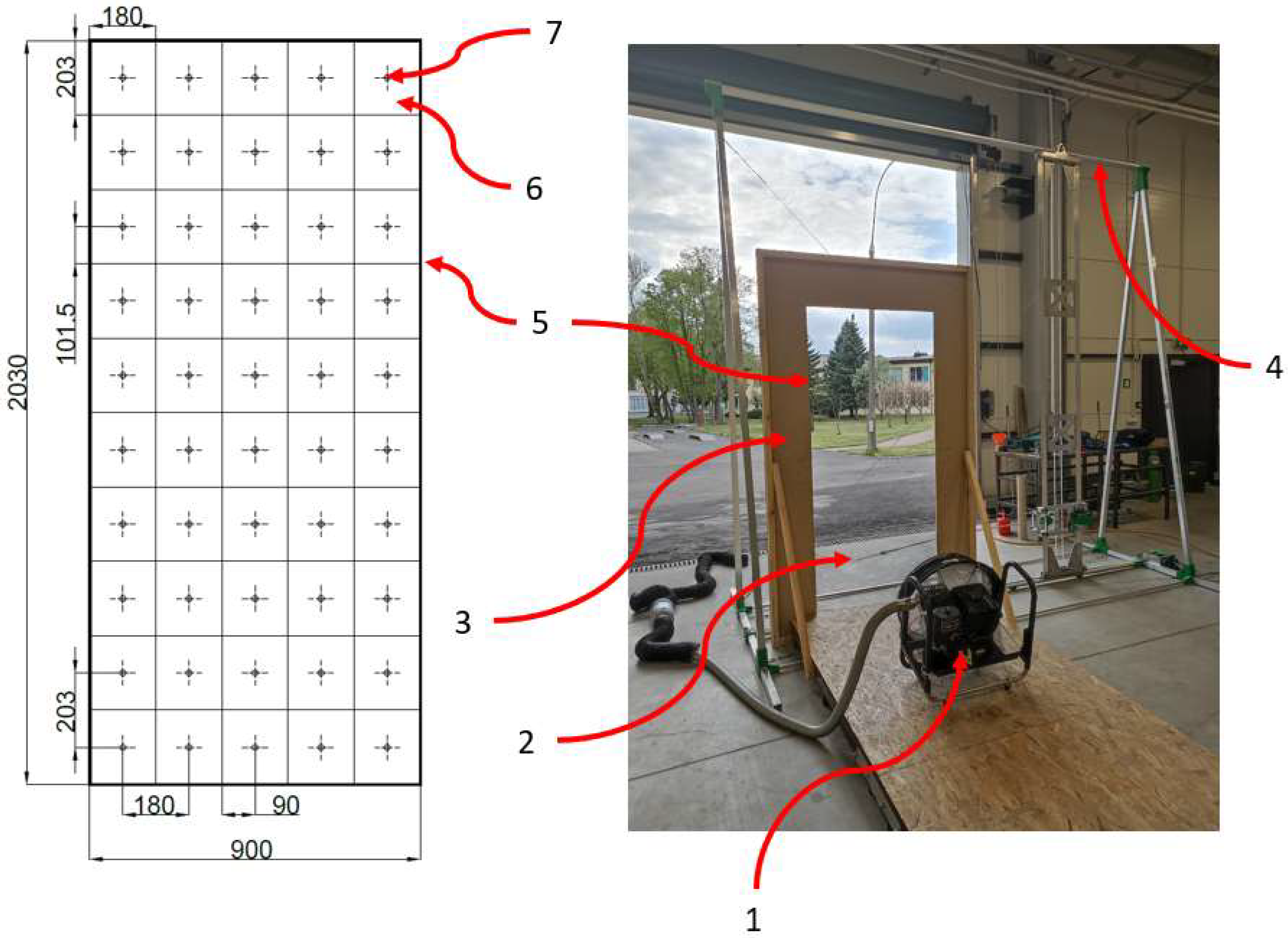
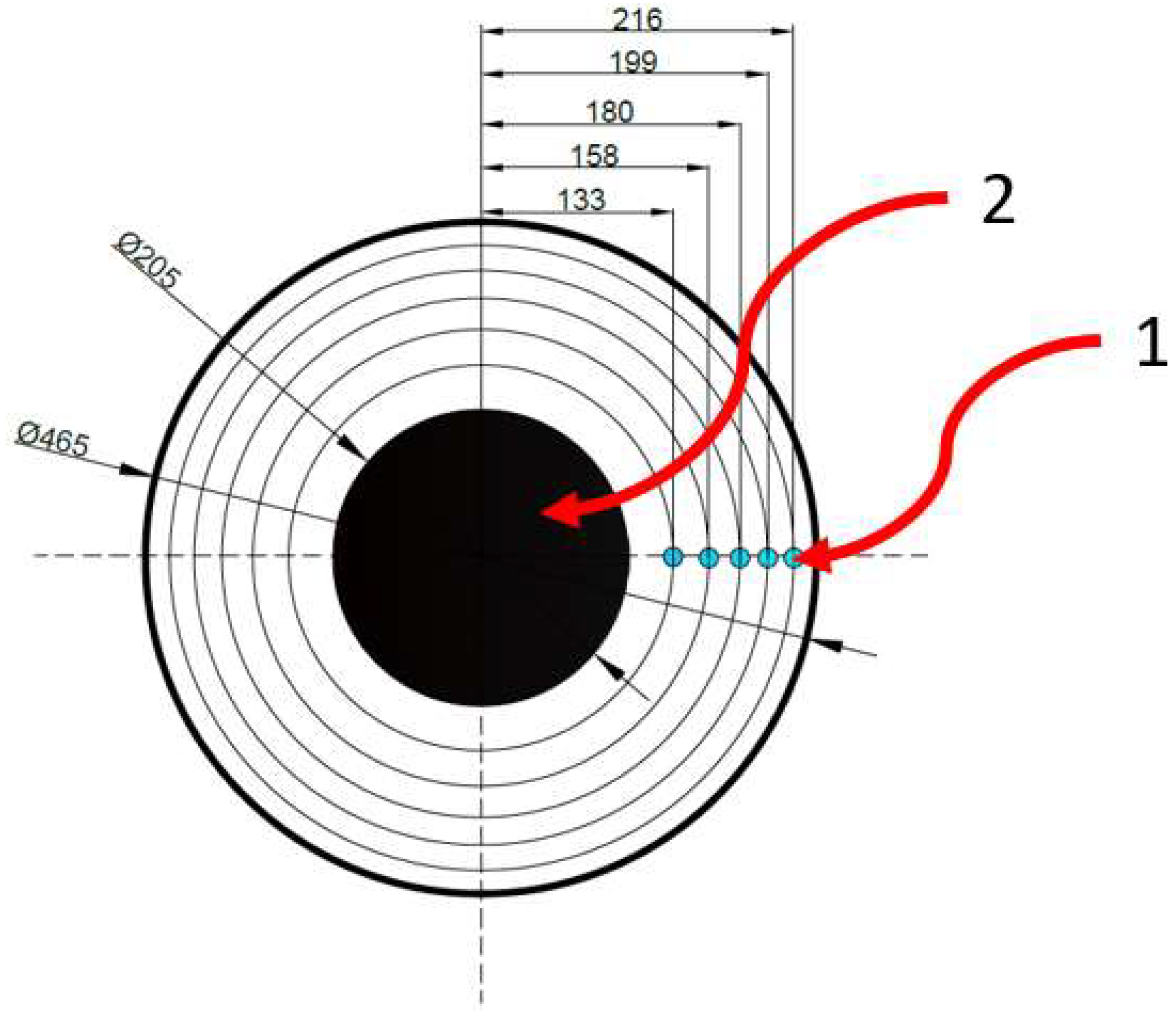
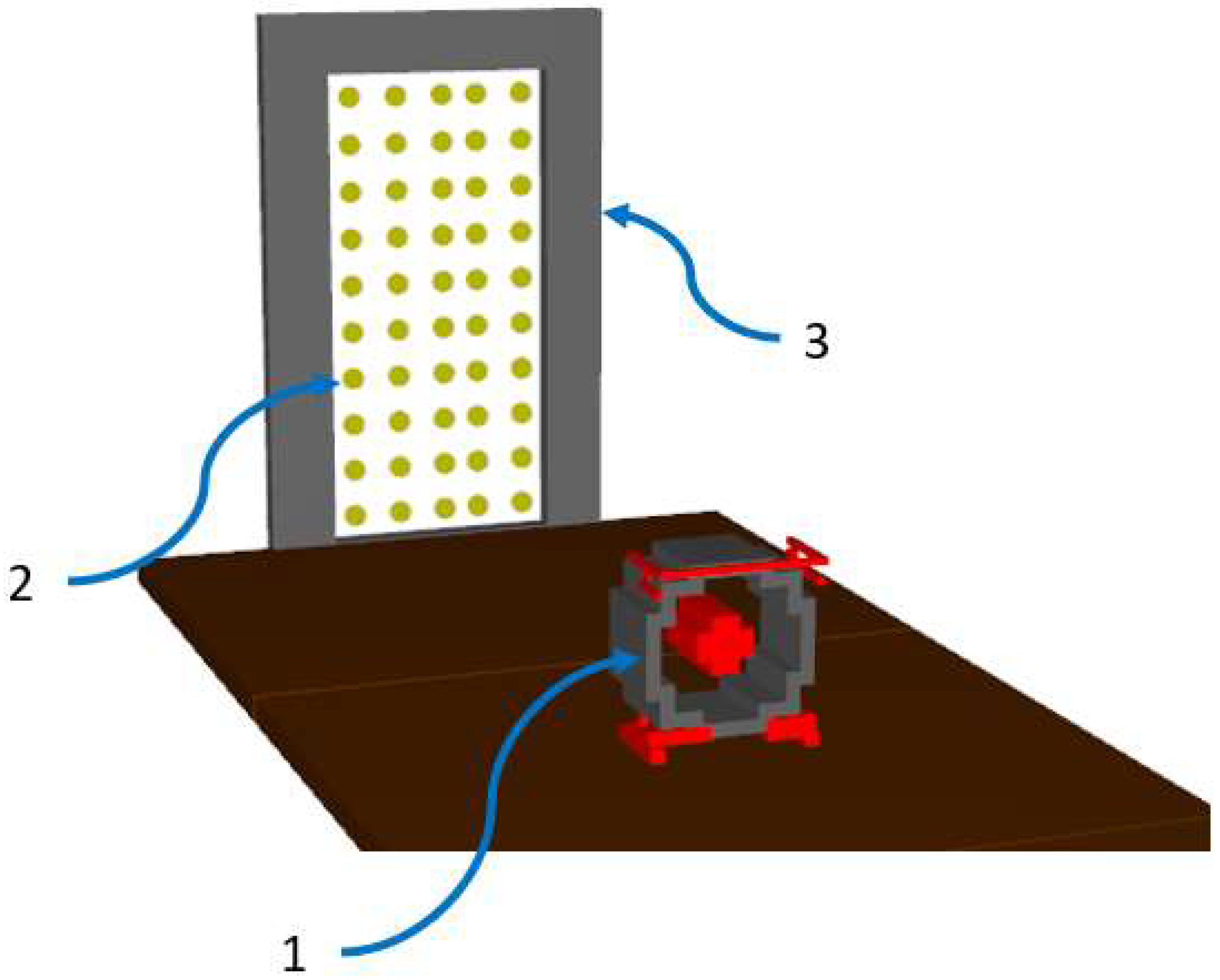

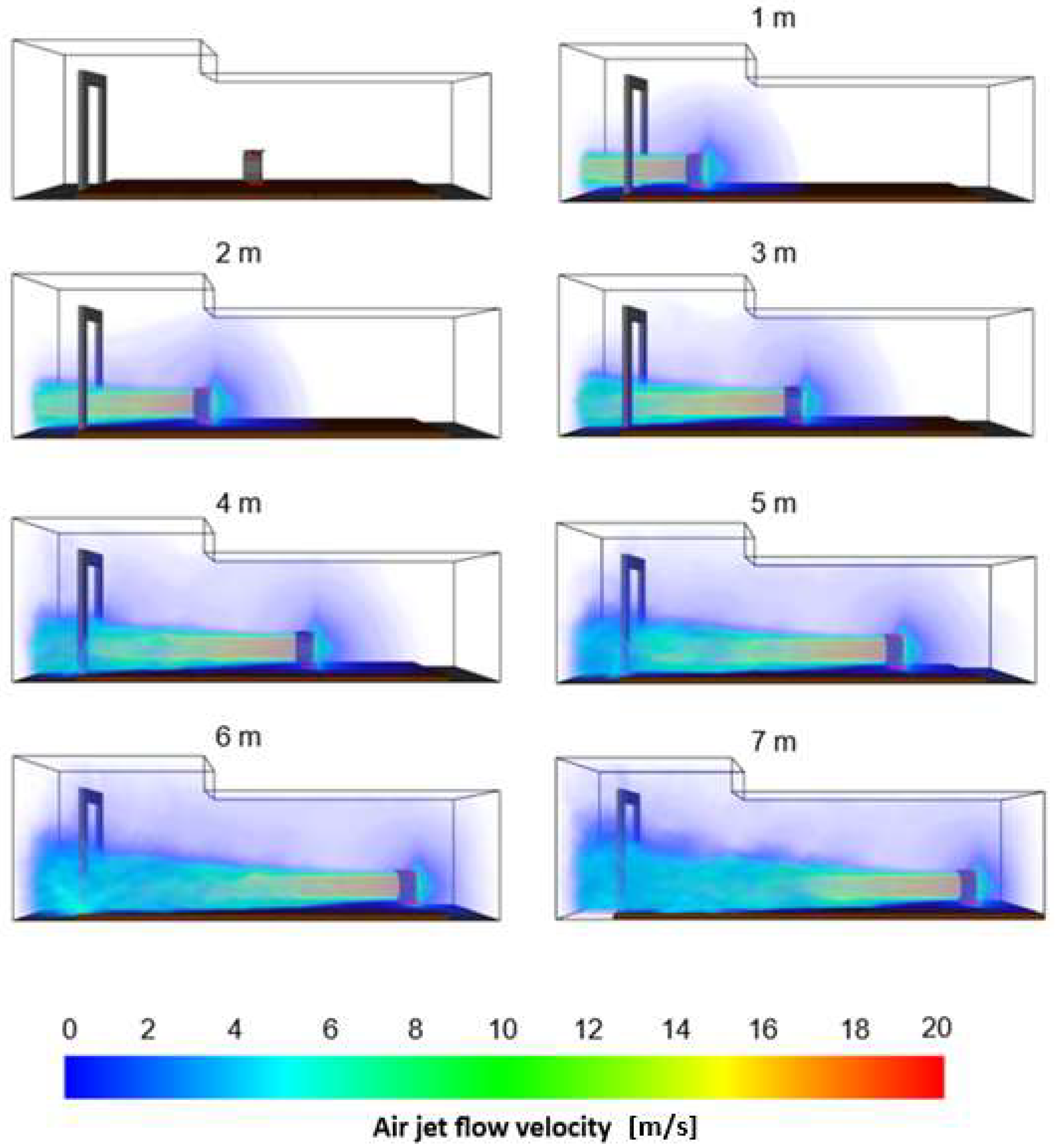
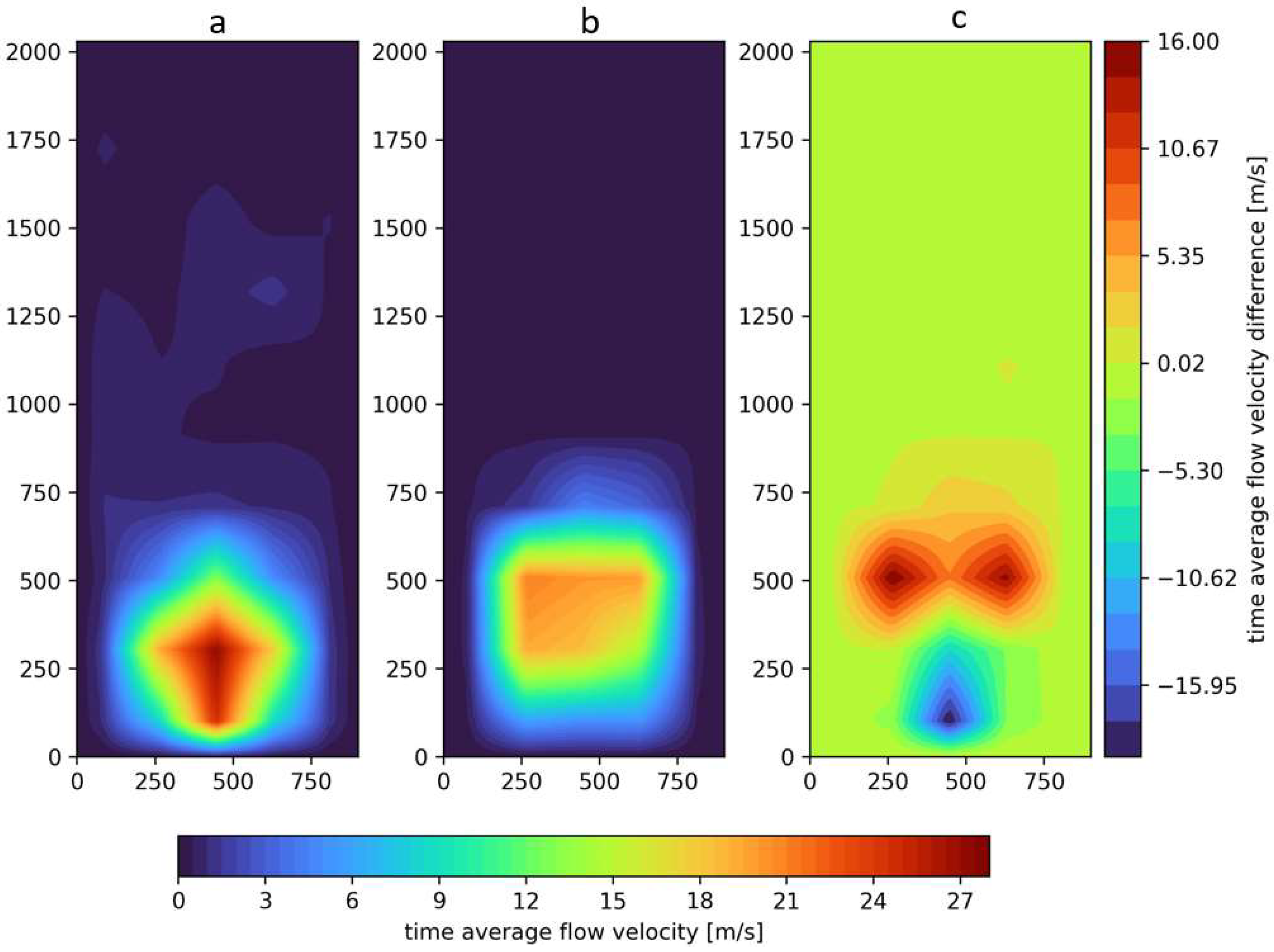
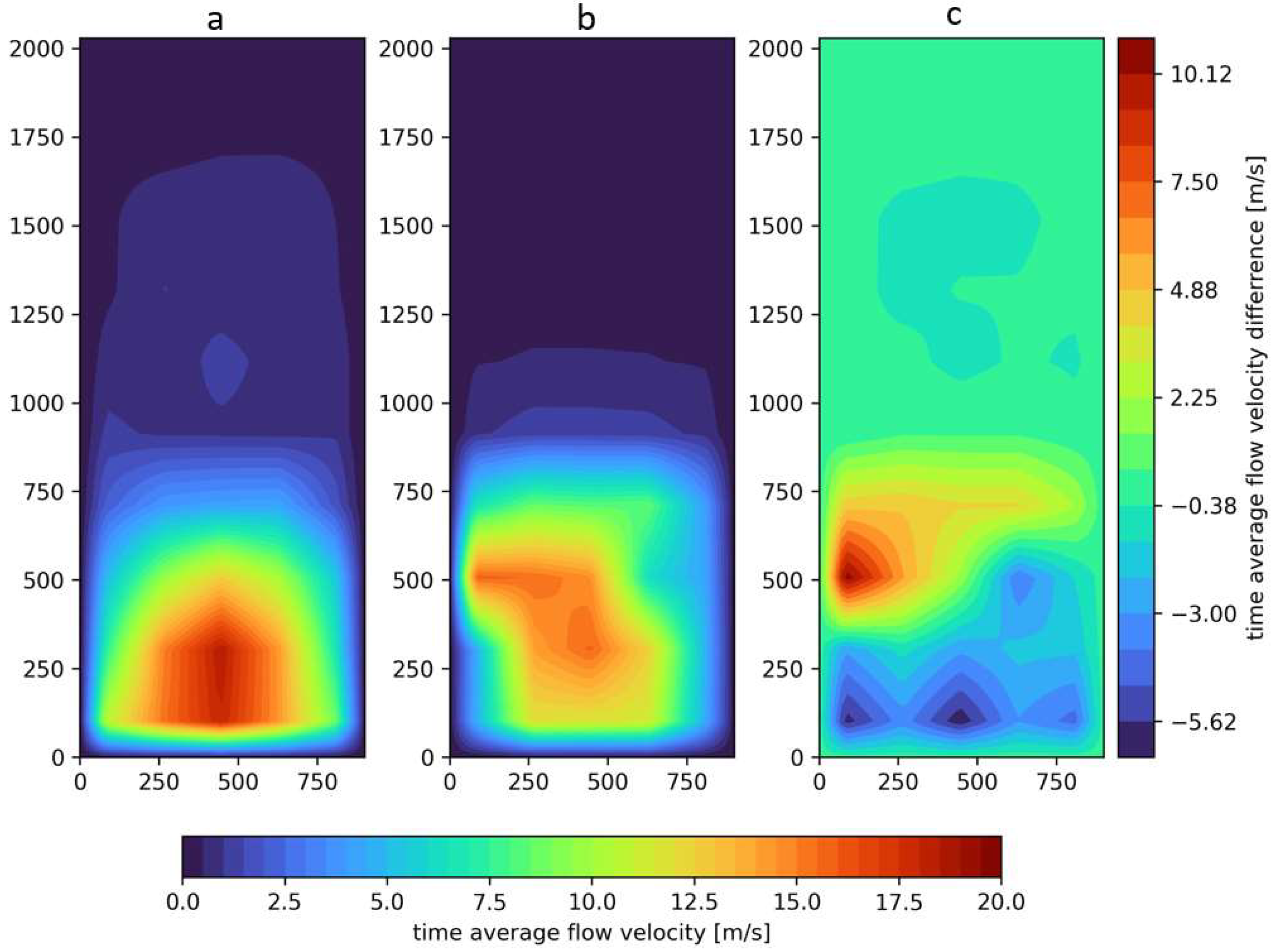
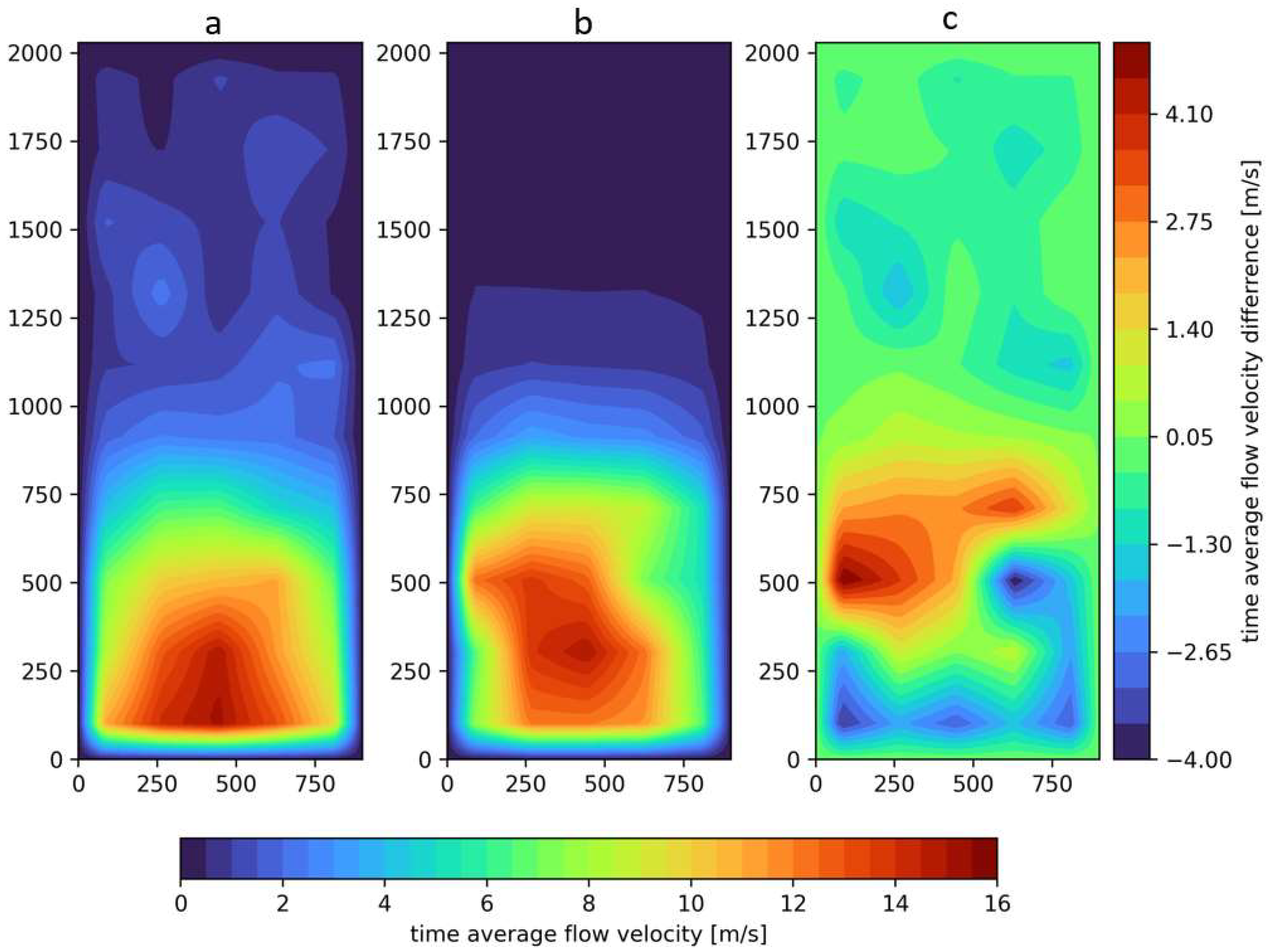
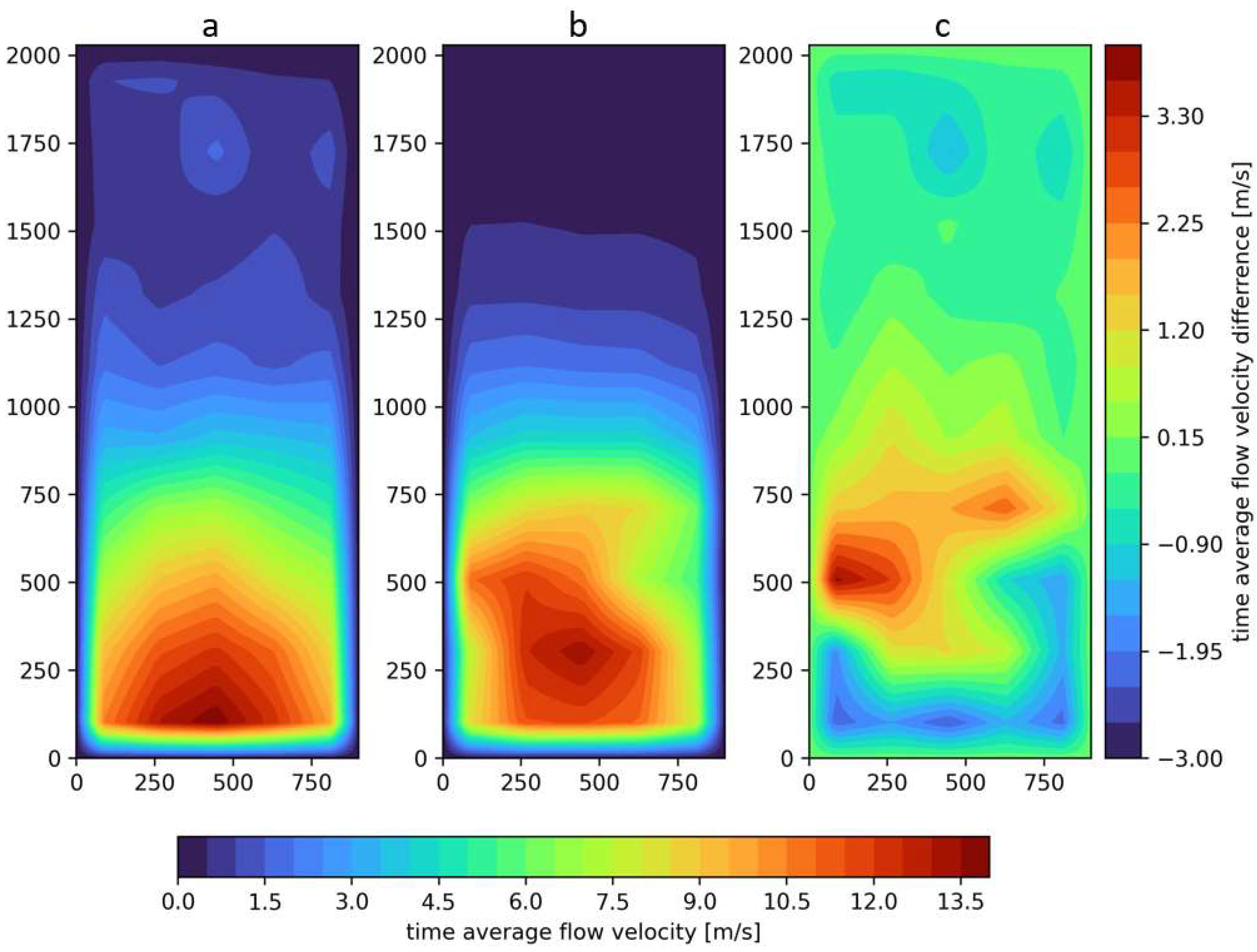
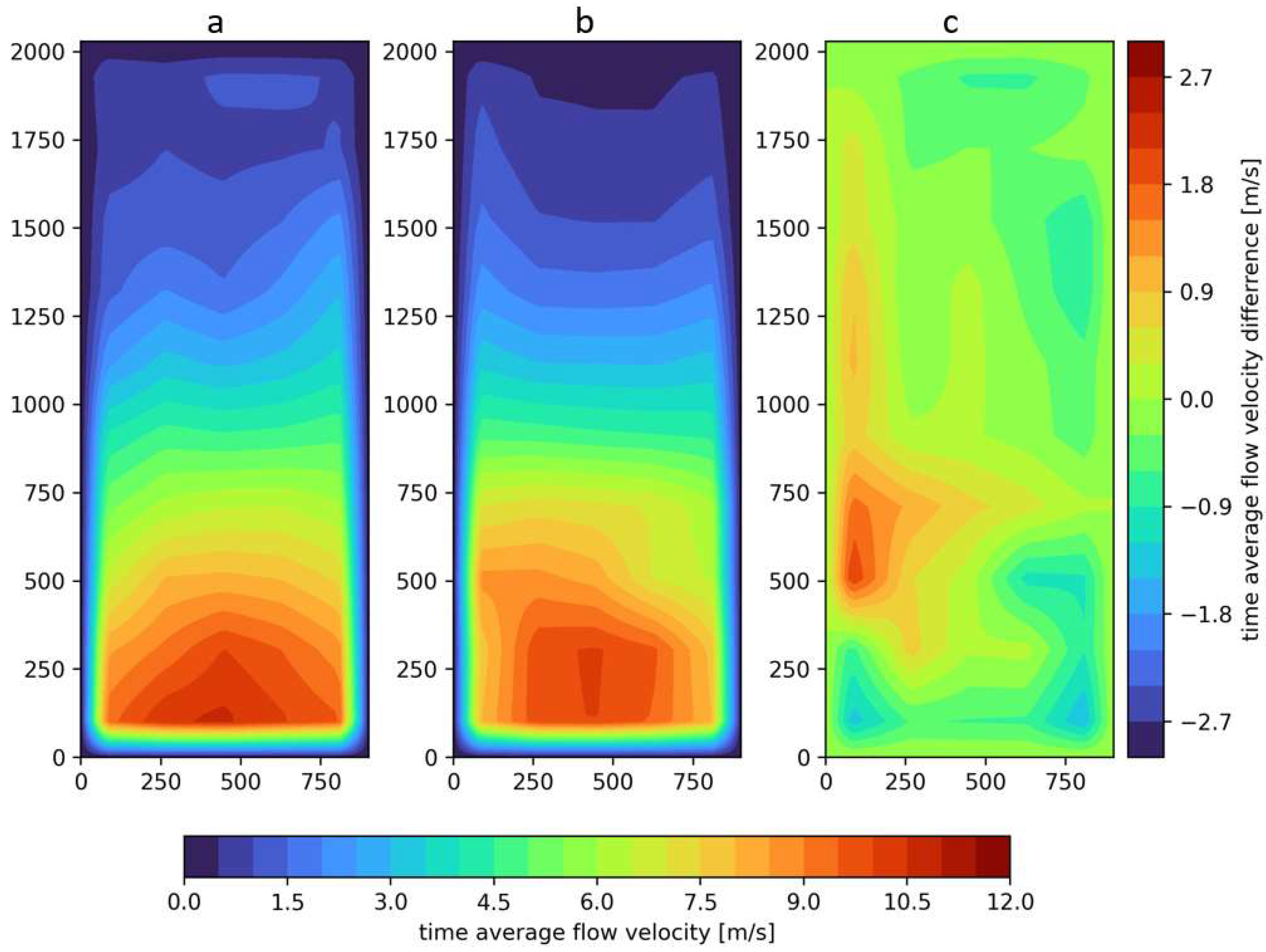
Disclaimer/Publisher’s Note: The statements, opinions and data contained in all publications are solely those of the individual author(s) and contributor(s) and not of MDPI and/or the editor(s). MDPI and/or the editor(s) disclaim responsibility for any injury to people or property resulting from any ideas, methods, instructions or products referred to in the content. |
© 2025 by the authors. Licensee MDPI, Basel, Switzerland. This article is an open access article distributed under the terms and conditions of the Creative Commons Attribution (CC BY) license (https://creativecommons.org/licenses/by/4.0/).
Share and Cite
Kaczmarzyk, P.; Ziegler, B.; Warguła, Ł.; Burdzy, T.; Popielarczyk, T.; Sowa, T.; Antosiewicz, P. Experimental Studies and Computational Fluid Dynamics Simulations to Evaluate the Characteristics of the Air Velocity Profile Generated by the Positive Pressure Ventilator. Appl. Sci. 2025, 15, 2332. https://doi.org/10.3390/app15052332
Kaczmarzyk P, Ziegler B, Warguła Ł, Burdzy T, Popielarczyk T, Sowa T, Antosiewicz P. Experimental Studies and Computational Fluid Dynamics Simulations to Evaluate the Characteristics of the Air Velocity Profile Generated by the Positive Pressure Ventilator. Applied Sciences. 2025; 15(5):2332. https://doi.org/10.3390/app15052332
Chicago/Turabian StyleKaczmarzyk, Piotr, Bartosz Ziegler, Łukasz Warguła, Tomasz Burdzy, Tomasz Popielarczyk, Tomasz Sowa, and Piotr Antosiewicz. 2025. "Experimental Studies and Computational Fluid Dynamics Simulations to Evaluate the Characteristics of the Air Velocity Profile Generated by the Positive Pressure Ventilator" Applied Sciences 15, no. 5: 2332. https://doi.org/10.3390/app15052332
APA StyleKaczmarzyk, P., Ziegler, B., Warguła, Ł., Burdzy, T., Popielarczyk, T., Sowa, T., & Antosiewicz, P. (2025). Experimental Studies and Computational Fluid Dynamics Simulations to Evaluate the Characteristics of the Air Velocity Profile Generated by the Positive Pressure Ventilator. Applied Sciences, 15(5), 2332. https://doi.org/10.3390/app15052332







